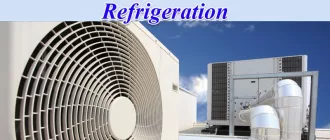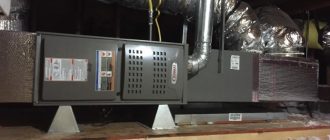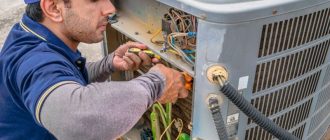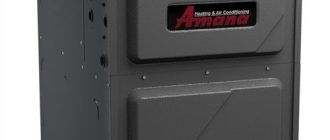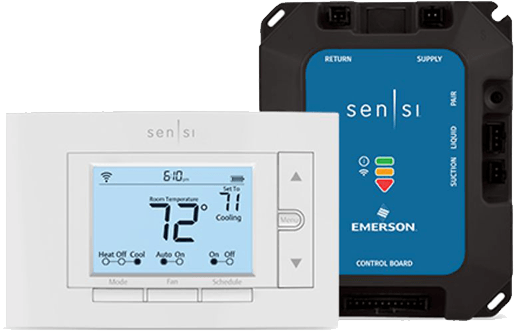
The Future of HVAC: How Smart is Your Thermostat?
In today’s wireless world, it is no surprise that even our thermostats are becoming smarter. With advancements in technology and the rise of smart home automation, the future of HVAC is looking more energy-efficient and convenient than ever before.
Gone are the days of manually adjusting the thermostat to find the perfect temperature. Smart thermostats are equipped with sensors that can detect the presence of people in a room and adjust the temperature accordingly. This not only saves energy but also ensures that the room is always at a comfortable temperature.
But the benefits of a smart thermostat don’t stop there. These devices can also learn your habits and preferences over time, making automatic adjustments to the temperature based on your unique needs. Whether you prefer a cooler sleeping environment or a warmer living room, a smart thermostat can adapt to your schedule and make your home more comfortable.
One of the key advantages of smart thermostats is their ability to connect to other smart home devices. This means that you can control your thermostat through your smartphone or other smart devices, even when you’re not at home. Imagine being able to adjust the temperature from your office, so that your home is nice and cozy by the time you arrive.
As technology continues to evolve, the future of HVAC looks brighter than ever. With the rise of smart thermostats and other energy-saving devices, we are moving towards a more efficient and sustainable future. So, how smart is your thermostat?
The Evolution of HVAC Systems
The field of HVAC (Heating, Ventilation, and Air Conditioning) has seen significant advancements in recent years. From simple thermostats that required manual adjustments to smart thermostats that can be controlled remotely, the evolution of HVAC systems has revolutionized the way we control our indoor environments.
The introduction of smart thermostats has allowed homeowners to have more control over their HVAC systems than ever before. These thermostats utilize advanced technology and sensors to monitor the temperature and humidity levels in a building. With the help of automation, wireless connectivity, and machine learning algorithms, smart thermostats can adjust the temperature settings based on user preferences and occupancy patterns, ensuring optimal comfort and energy efficiency.
One of the key features of smart thermostats is their ability to connect to other smart devices in the home, such as lights, door locks, and security systems. This integration allows for a more holistic approach to energy management, where the HVAC system can work in tandem with other devices to optimize energy usage. For example, when the smart thermostat detects that no one is home, it can automatically adjust the temperature to a more energy-efficient level and turn off unnecessary lights.
The rise of wireless connectivity has also contributed to the evolution of HVAC systems. With the advent of wireless sensors, homeowners can monitor temperature, humidity, and air quality in different rooms of their homes. This allows for more precise control over the HVAC system, as users can adjust the settings based on the specific needs of each room. For example, if a particular room tends to get too hot during the day, the user can program the HVAC system to cool that room specifically.
In addition to improving comfort and energy efficiency, the evolution of HVAC systems has also led to a reduction in maintenance costs. Smart thermostats can provide valuable insights into the performance of the HVAC system, alerting users to any potential issues or malfunctions. This proactive approach to maintenance can help prevent costly repairs and extend the lifespan of the system.
In conclusion, the HVAC industry has come a long way with the advent of smart thermostats, wireless sensors, and advanced technology. These advancements have made HVAC systems more intelligent, energy-efficient, and user-friendly. As technology continues to evolve, we can expect even more innovative solutions that will further improve the comfort and efficiency of our indoor environments.
The Benefits of Upgrading to a Smart Thermostat
Upgrading to a smart thermostat offers a variety of benefits, including increased energy efficiency, improved HVAC system performance, and enhanced comfort in your home. With advancements in technology, smart thermostats have become an essential part of the future of home automation.
One of the key advantages of a smart thermostat is its energy-efficient capabilities. These devices are designed to optimize your HVAC system’s performance by adjusting temperature settings based on your preferences and the occupancy of your home. By automatically adjusting the temperature when you are away or asleep, you can save energy and reduce your utility bills.
In addition to energy savings, a smart thermostat also provides improved HVAC system performance. These devices allow you to monitor and control your HVAC system remotely, giving you the flexibility to adjust the settings from anywhere using your smartphone or other wireless devices. This level of control ensures that your home is always at the desired temperature, and you can easily make adjustments to meet your comfort needs.
Another benefit of upgrading to a smart thermostat is the automation features it offers. These devices can learn your daily routines and preferences and adjust the temperature accordingly. For example, the thermostat can gradually reduce the temperature when you usually leave for work and start increasing it before you return home, ensuring a comfortable environment upon your arrival. This automation eliminates the need for manual adjustments and ensures that your home is always comfortable without wasting energy.
Finally, smart thermostats offer wireless connectivity, allowing you to connect them to other smart home devices. This integration enables a more seamless home automation experience. For example, you can connect your smart thermostat to your smart lighting system or blinds, allowing them to adjust the lighting and natural light levels based on the temperature and occupancy settings.
| Increased energy efficiency |
| Improved HVAC system performance |
| Enhanced comfort in your home |
| Automation features |
| Wireless connectivity |
In conclusion, upgrading to a smart thermostat offers numerous benefits such as increased energy efficiency, improved HVAC system performance, enhanced comfort, automation features, and wireless connectivity. Investing in this smart technology can help you save energy, reduce utility costs, and create a more comfortable living environment in your home.
Energy Savings with Smart Thermostats
One of the main benefits of smart thermostats is their ability to save energy and reduce utility costs. With the continuous advancements in technology, the future of HVAC systems is becoming more connected and automated. Smart thermostats utilize advanced sensors and smart algorithms to optimize your home’s heating, ventilation, and air conditioning (HVAC) system.
By using smart thermostats, you can have better control over your home’s temperature, resulting in improved energy efficiency. These devices can learn your daily routines and adjust the temperature accordingly, ensuring a comfortable environment when you are home and saving energy while you are away.
Smart thermostats also come with wireless connectivity, allowing you to control them remotely through your smartphone or other smart devices. This feature enables you to adjust your home’s temperature even when you are not at home, helping you save energy and keep your home comfortable.
Additionally, smart thermostats can integrate with other smart devices in your home, such as smart lighting and smart blinds. By utilizing automation, these devices can work together to optimize energy usage. For example, when your smart thermostat detects that you have left the house, it can communicate with the smart blinds to close them, preventing heat loss in winter or heat gain in summer.
Overall, smart thermostats offer a reliable and energy-efficient solution for HVAC management in your home. With their advanced technology and connectivity, they provide optimum comfort while reducing energy consumption and utility costs. Investing in a smart thermostat can be a smart choice for both your comfort and your wallet.
Increased Comfort and Convenience
The future of HVAC technology is here, and it’s all about making your home more comfortable and convenient. With the advent of wireless sensors and automation, smart thermostats are becoming the new norm in energy-efficient HVAC systems.
Imagine a world where your thermostat knows your preferences and adjusts the temperature accordingly. No more waking up to a chilly morning or coming home to a stuffy house. With smart thermostats, you can set your desired temperature and let the system do the rest.
Not only do these smart thermostats provide increased comfort, but they also offer unparalleled convenience. Most models come with smartphone apps that allow you to control your HVAC system from anywhere. Whether you’re lying in bed or sitting in the office, you can easily adjust the temperature or turn the system on or off.
Another advantage of smart thermostats is their ability to learn your schedule and adapt accordingly. They can detect when you’re away from home and automatically adjust the temperature to save energy. When they sense you’re about to come back, they can start heating or cooling your house so it’s comfortable when you arrive.
Furthermore, smart thermostats can also integrate with other smart devices in your home. You can connect them to your voice assistants like Amazon Alexa or Google Home, allowing you to control your HVAC system with voice commands. You can even sync them with your home automation systems, so your HVAC adjusts automatically when you turn on the lights or open your front door.
In summary, the future of HVAC is smart, wireless, and energy-efficient. With the increasing popularity of smart thermostats, homeowners can enjoy increased comfort and convenience in their homes. From adjusting the temperature with your phone to integrating with other smart devices, these thermostats offer a new level of control and automation.
Compatibility with Smart Home Technology
The future of HVAC systems is becoming increasingly smart and connected, thanks to advancements in technology. One key aspect of this evolution is the compatibility of HVAC systems with smart home technology.
Sensors play a crucial role in the energy-efficient automation of HVAC systems. Smart thermostats utilize wireless sensors to gather data about temperature, occupancy, and humidity levels in a room. This information is then used to adjust heating and cooling settings accordingly, ensuring optimal comfort while minimizing energy consumption.
Compatibility with smart home technology means that HVAC systems can seamlessly integrate with other smart devices in a home. For example, a smart thermostat can communicate with a smart lighting system to adjust brightness based on occupancy and natural light levels. It can also work in tandem with a smart security system to automatically adjust temperature settings when the occupants are away, helping to save energy and lower utility bills.
Smart thermostats are not only compatible with other smart devices, but they also offer a range of features that make them more user-friendly and convenient. They can be controlled remotely through smartphone apps, allowing homeowners to adjust settings even when they are not at home. Some models even have voice control capabilities, enabling hands-free operation.
The compatibility of HVAC systems with smart home technology holds promise for a more energy-efficient and comfortable future. With the ability to integrate with other smart devices and offer advanced features, smart thermostats are revolutionizing the way we control and manage heating and cooling in our homes.
| 1. Energy efficiency: Smart thermostats can optimize heating and cooling settings based on occupancy and ambient conditions, leading to reduced energy consumption. |
| 2. Convenience: Remote control and voice control capabilities make it easier than ever to adjust HVAC settings to fit your preferences, even when you’re not at home. |
| 3. Integration with other smart devices: Smart thermostats can communicate and integrate with other smart devices in your home, creating a more cohesive and efficient smart home ecosystem. |
| 4. Cost savings: By optimizing energy usage and reducing wastage, compatibility with smart home technology can lead to lower utility bills over time. |
Controlling Your HVAC System Remotely
The future of HVAC systems is becoming more efficient and convenient with the advancements in technology. One of the key features of these systems is the ability to control them remotely, providing homeowners with convenience and energy savings.
Wireless technology has revolutionized the way we interact with our HVAC systems. With the advent of smart thermostats, homeowners can now control their HVAC systems from anywhere in the world using their smartphones or tablets.
Smart thermostats are equipped with sensors that can detect when you are not at home and adjust the temperature accordingly, saving energy and reducing utility costs. They can also learn your preferences over time and automatically adjust the temperature to ensure optimal comfort.
Controlling your HVAC system remotely has numerous benefits. For example, if you are coming back from vacation and want your home to be the perfect temperature when you arrive, you can simply adjust the thermostat from your mobile device while on the go.
Furthermore, if you forgot to turn off the heat or AC before leaving the house, you can easily do so from your smartphone, avoiding unnecessary energy consumption and costs.
In addition, remote control of your HVAC system allows for easy troubleshooting. If there is an issue with your system, you can check the thermostat settings remotely to see if there are any error messages or malfunctions. This can save you time and money on service calls.
The future of HVAC systems is moving towards a more connected and smarter home. With remote control capabilities, homeowners can enjoy the convenience and energy savings that come with a smart HVAC system. As technology continues to advance, we can expect even more innovative features to enhance our HVAC experience.
Integration with Voice Assistants
The future of HVAC is all about automation and making our lives easier and more comfortable. One of the latest advancements in smart thermostat technology is the integration with voice assistants.
Voice assistants like Alexa, Google Assistant, and Siri have become an integral part of our daily lives. We rely on them to answer questions, play music, and control our various smart devices. Now, with the integration of HVAC systems, voice assistants can control the temperature and settings of our thermostats too.
This integration allows for a seamless and convenient way to control your HVAC system. Instead of having to manually adjust your thermostat, you can simply use voice commands. For example, you can say “Alexa, set the temperature to 72 degrees” or “Hey Google, lower the thermostat by 3 degrees”. The voice assistant will immediately relay your commands to the thermostat, making it easy to achieve your desired comfort level without even needing to get up from your seat.
In addition to controlling the temperature, voice assistants can also provide you with information and insights about your HVAC system. You can ask questions like “Hey Siri, what is the current temperature in my home?” or “Alexa, how long has the HVAC been running today?”. This provides you with valuable data and allows you to make informed decisions about your energy usage and overall efficiency.
The integration of voice assistants with HVAC systems is a step towards a more energy-efficient future. With the ability to control and monitor your thermostat using voice commands, you can optimize your HVAC settings and save energy. For example, you can set up schedules or routines that automatically adjust the temperature when you leave the house or go to bed. This ensures that your HVAC system is only running when it’s needed, reducing energy waste and lowering your carbon footprint.
| – Convenient and hands-free control of your thermostat |
| – Instant feedback and information about your HVAC system |
| – Energy-efficient optimization of HVAC settings |
| – Reduction of energy waste and carbon footprint |
In conclusion, the integration of voice assistants with HVAC systems is an exciting development in smart thermostat technology. It offers a more convenient and hands-free way to control your thermostat, provides valuable insights about your HVAC system, and contributes to a more energy-efficient future. With the rapid advancement of technology, we can expect even more innovative features and improvements in the future.
Customization and Personalization
As the future of HVAC technology advances, customization and personalization have become key features of energy-efficient thermostats. With the advent of automation and wireless sensors, thermostats can now be programmed to adjust temperatures based on individual preferences and patterns.
Smart thermostats now offer a range of customizable options, allowing users to set temperature schedules for different times of the day or week. This level of customization ensures optimal comfort and energy savings by adjusting the HVAC system to meet specific needs.
Furthermore, personalization extends beyond just temperature settings. Some thermostats offer additional features such as voice control, learning algorithms, and integration with other smart devices in the home. These features allow for a truly personalized experience, where the thermostat can adapt and optimize settings based on user habits and environmental conditions.
By tailoring the HVAC system to individual preferences and habits, energy efficiency is maximized. Smart thermostats can learn when a user typically leaves the house and adjust the temperature accordingly, saving energy while maintaining a comfortable environment. They can also detect when someone is home based on sensor input, ensuring that the HVAC system is not wasting energy in an empty house.
Wireless connectivity allows for easy control and monitoring of the HVAC system from anywhere, providing convenience and peace of mind. Whether it’s adjusting the temperature remotely or receiving energy usage reports, users have full control over their HVAC system at all times.
In conclusion, customization and personalization are pivotal aspects of the future of HVAC technology. Smart thermostats with advanced features and wireless connectivity offer users the ability to optimize comfort, maximize energy efficiency, and have full control over their HVAC systems. With these advancements, the future of HVAC looks promising for both consumers and the environment.
Real-Time Data Monitoring
In the future, energy-efficient technology will play a crucial role in managing HVAC systems. One key component of this technology is real-time data monitoring. By using sensors and smart thermostats, HVAC systems can collect and analyze data in real-time, allowing for more precise control over heating and cooling.
Real-time data monitoring works by continuously measuring various parameters such as temperature, humidity, and occupancy. These sensors are placed strategically throughout a building to capture data from different areas. The data is then transmitted wirelessly to a central controller or cloud-based system for analysis.
By leveraging real-time data monitoring, HVAC systems can adapt and respond to changing conditions more quickly and efficiently. For example, if a room is not in use, the thermostat can detect the lack of occupancy and adjust the temperature accordingly, saving energy in the process. Similarly, if a room is consistently warmer than others, the system can identify the issue and make adjustments to ensure a more comfortable environment.
| 1. Energy savings: Real-time data monitoring allows HVAC systems to optimize energy usage by adjusting settings based on actual occupancy and environmental conditions. |
| 2. Improved comfort: By continuously monitoring temperature and humidity, the system can make small adjustments to maintain a consistent and comfortable indoor environment. |
| 3. Predictive maintenance: Real-time data monitoring can identify potential issues before they become major problems, allowing for proactive maintenance and reducing downtime. |
| 4. Remote control and monitoring: With wireless connectivity, real-time data monitoring enables remote control and monitoring of HVAC systems, providing flexibility and convenience for users. |
In conclusion, real-time data monitoring is an essential component of the future of HVAC technology. By leveraging sensors, smart thermostats, and wireless connectivity, HVAC systems can optimize energy usage, improve comfort, and enable remote control and monitoring. This technology has the potential to revolutionize the way we manage and interact with our HVAC systems, making them smarter and more efficient than ever before.
Smart Thermostats and Sustainability
As the future of HVAC technology continues to evolve, smart thermostats are emerging as a key component in creating more sustainable and energy-efficient homes and buildings. These innovative devices are equipped with sensors and automation capabilities that allow them to optimize heating, ventilation, and air conditioning (HVAC) systems.
One of the main advantages of smart thermostats is their ability to learn and adapt to the needs and preferences of the users. They can automatically adjust temperature settings based on occupancy patterns, weather conditions, and even individual habits. By detecting when a room is unoccupied, for example, a smart thermostat can automatically reduce energy consumption, resulting in significant energy savings.
Smart thermostats also leverage wireless technology to provide seamless connectivity and control. With the help of mobile apps, users can remotely monitor and adjust their HVAC systems from anywhere, ensuring optimal comfort and energy efficiency. This level of convenience and control allows homeowners and building managers to easily manage their energy usage, reducing waste and lowering their carbon footprint.
Furthermore, smart thermostats can work in synergy with other smart devices and technologies, such as occupancy sensors, weather stations, and even voice assistants. This interconnectedness enables a comprehensive and intelligent HVAC system that constantly optimizes performance, ensuring the highest levels of comfort while minimizing energy consumption.
In addition to their energy-saving potential, smart thermostats also contribute to sustainability by promoting the use of renewable energy sources. Many smart thermostats can be programmed to maximize the use of solar or wind-generated power, further reducing dependence on fossil fuels and decreasing the overall environmental impact.
In conclusion, smart thermostats are revolutionizing the HVAC industry, offering a future of energy-efficient and sustainable heating and cooling solutions. With their advanced sensors, automation capabilities, and wireless technology, these devices are empowering users to take control of their energy consumption, reduce waste, and pave the way for a greener and more sustainable future.
Improved Indoor Air Quality
In the future of HVAC, the focus on indoor air quality has become increasingly important. With the advancement of technology and the integration of smart features, sensors in HVAC systems have allowed for automation and better control of air quality in homes and buildings.
A smart thermostat, equipped with wireless capabilities, can monitor the air quality in real-time and make adjustments accordingly. This technology allows for the detection and removal of harmful particles, such as allergens, pollutants, and volatile organic compounds (VOCs).
By utilizing sensors, a smart thermostat can measure the temperature, humidity, and air pollution levels inside a building. It can then automatically adjust HVAC settings to improve air quality, such as increasing ventilation or activating air purifiers and filters.
This automation not only improves the overall air quality but also benefits the health and well-being of the occupants. Good indoor air quality can reduce the risk of respiratory illnesses, allergies, and other health conditions caused by poor air circulation and pollutant exposure.
Furthermore, with the integration of smart technology, homeowners and building managers can monitor and control air quality remotely through mobile applications. This allows for greater convenience and customization, as users can adjust settings and receive notifications about air quality changes from anywhere at any time.
Overall, the future of HVAC and smart thermostats will continue to prioritize and improve indoor air quality. Through the use of sensors, automation, and wireless technology, we can expect to see better control of air pollutants and a healthier environment for everyone.
Smart Thermostats and HVAC Maintenance
With the rapid advancement of wireless technology, smart thermostats have become increasingly popular in the HVAC industry. These devices combine the power of sensors and automation to provide homeowners with greater control over their heating and cooling systems.
A smart thermostat is a device that can communicate with other smart devices in your home, such as your smartphone or tablet. This technology allows you to remotely control your HVAC system, adjusting the temperature and settings even when you’re not at home. By using your smartphone, you can turn on the air conditioning before you arrive home on a hot summer day, ensuring a cool and comfortable environment.
One of the key benefits of smart thermostats is their ability to learn and adapt to your daily routine. By monitoring your behavior and preferences, these devices can automatically adjust the temperature to ensure maximum comfort and energy efficiency. For example, if you typically turn down the heat at night, a smart thermostat can learn this pattern and automatically adjust the temperature accordingly.
In addition to providing convenience and comfort, smart thermostats can also help with HVAC maintenance. These devices can provide alerts and notifications when it’s time to change filters or schedule routine maintenance. By staying on top of these tasks, you can prolong the life of your HVAC system and ensure it operates at peak efficiency.
Looking to the future, smart thermostats are only expected to become smarter and more advanced. With advancements in artificial intelligence and machine learning, these devices will become even better at predicting and adapting to your needs. Imagine a thermostat that knows when you’re coming home and adjusts the temperature accordingly, or a thermostat that can detect when there’s a problem with your HVAC system and automatically schedule a repair.
In conclusion, smart thermostats are revolutionizing the HVAC industry by combining technology and automation. These devices offer greater control over your heating and cooling systems, providing convenience, comfort, and energy efficiency. Furthermore, they can assist with HVAC maintenance, helping you stay on top of routine tasks and prolong the lifespan of your system. As technology continues to advance, smart thermostats are poised to play an even bigger role in the future of HVAC.
Q&A:
How can a smart thermostat improve energy efficiency in my home?
A smart thermostat can improve energy efficiency in your home by learning your preferences and adjusting the temperature accordingly. It can also be programmed to turn off when you’re not at home and turn on just before you return, reducing unnecessary energy usage.
Can a smart thermostat save me money on my energy bills?
Yes, a smart thermostat can save you money on your energy bills. By automatically adjusting the temperature based on your preferences and occupancy patterns, it can reduce energy waste and optimize energy usage, resulting in lower energy bills.
What features should I look for when choosing a smart thermostat?
When choosing a smart thermostat, you should look for features such as programmability, learning capabilities, compatibility with your HVAC system, remote control via smartphone, and integration with other smart home devices.
Is it difficult to install a smart thermostat?
Installing a smart thermostat can be done by following the manufacturer’s instructions and usually does not require professional assistance. However, it’s important to turn off the power to your HVAC system before starting the installation process to ensure safety.
Are there any privacy concerns with using a smart thermostat?
Using a smart thermostat does raise some privacy concerns as it collects data about your temperature preferences and occupancy patterns. However, reputable manufacturers take steps to secure this data and provide control over its usage. It’s important to choose a trusted brand and review their privacy policy before purchasing a smart thermostat.
What is a smart thermostat?
A smart thermostat is a device that can be connected to a home’s heating, ventilation, and air conditioning (HVAC) system and can be controlled remotely. It uses advanced algorithms and sensors to learn and analyze a home’s heating and cooling patterns and adjust the temperature accordingly to optimize energy efficiency and comfort.
How does a smart thermostat work?
A smart thermostat works by connecting to a home’s HVAC system and gathering data from sensors placed throughout the home. It uses this data, along with algorithms, to learn the homeowners’ preferences and create a personalized heating and cooling schedule. The thermostat can be controlled remotely through a smartphone app or via voice commands.

